What Is AI in Ecommerce?
It’s easy to say AI in E-commerce is about robots taking over tasks. But that’s a reductive view. The use of algorithms and learning models to evaluate massive amounts of data in order to make informed decisions that enhance customer experience and business procedures is the essence of artificial intelligence (AI) in online commerce. This could involve creating customized product recommendations, forecasting inventory needs, enabling automated customer service, or examining market patterns to determine dynamic pricing.
What truly makes AI in ecommerce remarkable is the fact that these systems keep getting smarter. Through machine learning in retail, your processes actually learn from customer behaviors over time, fine-tuning recommendations and anticipating trends. So the more data you accumulate, the better your AI solutions become at predicting and responding to consumer needs. This cyclical improvement can be a significant driver of ecommerce automation with AI, intensifying your ROI as customer interactions scale.
The Magic of AI-Driven Customer Personalization
Ever come across an online store that feels like it reads your mind? That’s what AI-driven customer personalization is designed to achieve. It’s the art of curating product lines, marketing messages, and user experiences so that each customer feels the store was built just for them. eCommerce giants use predictive analytics to guess which items might interest you next and serve up perfectly timed offers. Even smaller businesses can tap into this approach by implementing AI recommendation engines.
How It Works
AI algorithms collect behavioral data – from what users browse to what they put in their carts – and match those patterns to broader trends. Then, they adapt the platform’s product suggestions, highlight relevant promotions, and even tailor search results. In short, each shopper’s journey becomes unique, improving click-through rates and fostering loyalty.
Why You Should Care
Let’s face it. Customers today expect personalization. If your store doesn’t keep up, they might bounce to a competitor’s website that does. If you’re grappling with how to set up personalized recommendations without overwhelming your existing resources, our team at Buildfuture can step in and customize a solution that’s right for your audience size and product category.
AI-Powered Chatbots in Ecommerce: Better Support, Faster
One of the most visible ways artificial intelligence in ecommerce manifests is through interactive chatbots. Remember the countless times you’ve needed clarification about return policies or shipping timelines, and all you wanted was a quick answer? Chatbots handle these queries efficiently, often faster than human support agents. Rather than waiting in line for a phone representative, a user can hop into a chat interface and get instant solutions.
Beyond Basic FAQ
More advanced AI-powered chatbots in ecommerce don’t just pull from a scripted FAQ. They employ natural language processing (NLP) to interpret user questions in context, troubleshoot issues, and even escalate inquiries to a live person when necessary. In other words, it’s not the robotic experience it used to be years ago. Shoppers get the sense that someone is truly listening to them.
Implementation Tip
Though many chatbots are delivered “out of the box” by third-party providers, you’ll want to train and customize them to your specific brand tone and product lines. That means feeding them the right data sets (including product information, shipping rules, and returns policies) and conducting user testing to ensure they’ll handle real-world questions smoothly. If you’re running pilot tests of chatbots and unsure how to integrate them seamlessly, you might consider connecting with us at Buildfuture for tailored chatbot solutions.
Harnessing AI-Driven Pricing Strategies
If you’ve ever visited an online store multiple times in a single day and noticed price fluctuations, you’ve seen dynamic (or AI-driven) pricing strategies in action. AI for ecommerce marketing isn’t just about ad targeting; it’s also about adjusting product prices based on supply, demand, competitor pricing, and even external events. This is common in travel and real estate marketplaces, but retailers of all sizes are starting to realize its benefits.
Why Dynamic Pricing Matters
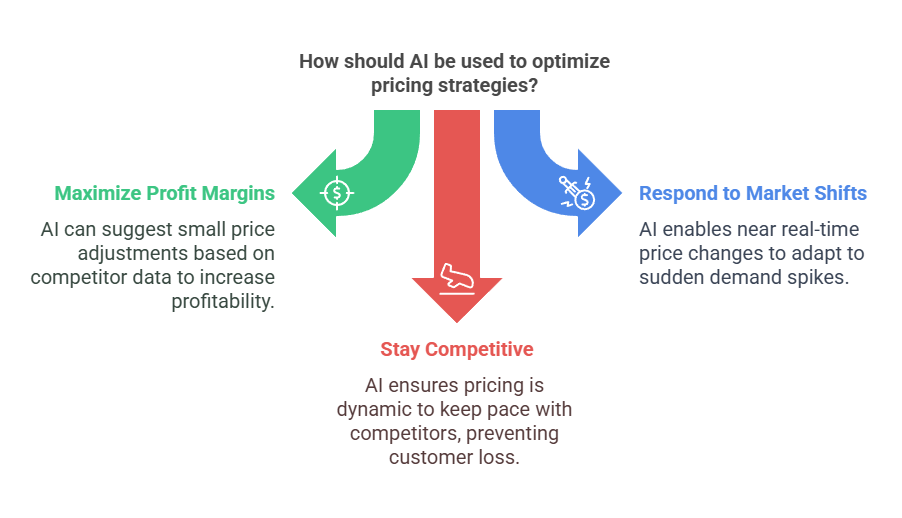
- Maximize Profit Margins: By analyzing competitor data, your AI algorithm can suggest small but profitable price changes.
- Respond to Market Shifts Instantly: Let’s say there’s a sudden spike in demand for a product. Traditional systems might delay updating prices for hours or even days, but an AI-based system can do it in near real-time.
- Stay Competitive: The retail market is fiercely competitive. If your store’s pricing is static while others rapidly adjust, you risk losing customers to more responsive competitors.
Dynamic pricing can feel complicated, especially for smaller operations worried about alienating longtime customers. The truth is, it’s all about striking the right balance. If you’re uncertain how to set these thresholds, you’re not alone. Many retailers enlist the services of AI ecommerce analytics experts (like our team) to ensure the approach is data-driven and fair.
Predictive Analytics for Demand Forecasting
Consider an online store that’s chronically running out of inventory on top-selling products, or conversely, stuck with piles of unsold stock in its warehouse. That’s money wasted either way. Ai for ecommerce growth often starts with getting inventory management under control, and that’s where predictive analytics makes an enormous difference.
Process Overview
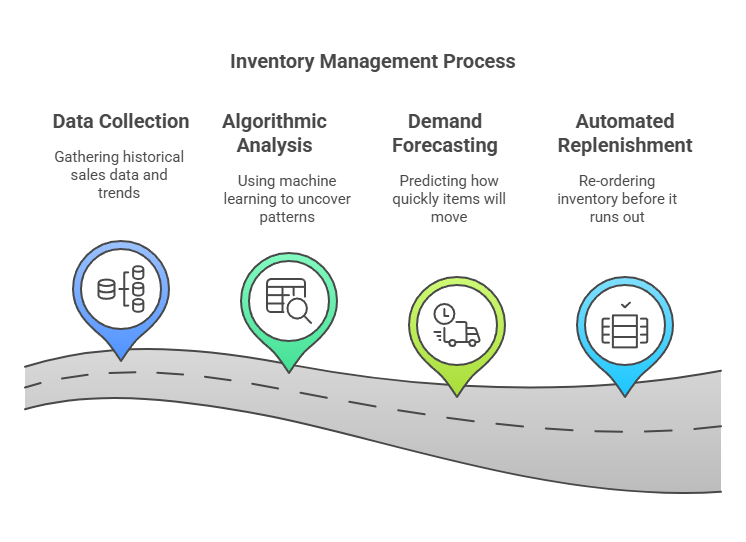
- Data Collection: Gather historical sales data, seasonality trends, and real-time market conditions.
- Algorithmic Analysis: Use machine learning in retail to uncover patterns, such as which products sell faster during holiday seasons and which languish.
- Demand Forecasting: Predict how quickly items will move from your warehouse shelves.
- Automated Replenishment: Intelligent systems can re-order inventory before it even runs out, helping you avoid “out of stock” notices.
Predictive analytics is powerful because it saves you from guesswork. It’s like having a crystal ball for your stock levels. I’ve seen organizations slash expenses and improve cash flow considerably by applying these techniques. If that piques your interest, you might want to explore a pilot program with Buildfuture to see how your existing platform can adopt these forecasting models without a massive overhaul.
AI-Powered Fraud Detection
Now, let’s pivot to risk management. Ecommerce is rife with fraudulent transactions—stolen credit card information, suspicious shipping addresses, and claims that never quite add up. AI and machine learning in retail security allow you to establish real-time checks and alerts that flag or block questionable orders. The goal is to minimize manual review time and reduce losses.
Key Mechanisms
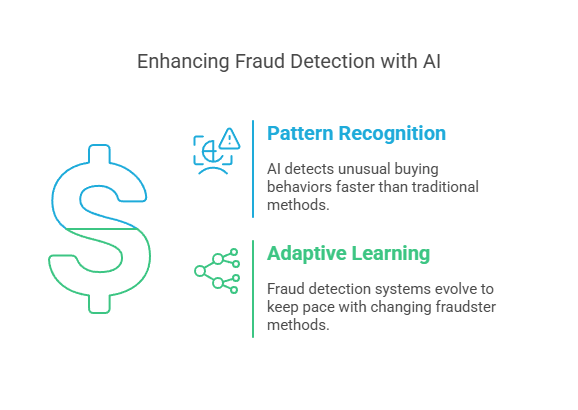
- Pattern Recognition: AI solutions detect abnormal buying behaviors quicker than traditional systems.
- Adaptive Learning: Fraudsters evolve their methods, so your fraud detection system should too. With every new dataset, machine learning guarantees that your system becomes more intelligent.
- False Positives: By reducing the quantity of valid transactions that are reported as suspicious, an AI-driven strategy seeks to enhance the client experience.
Of all, fraud detection may be complicated, and if devoted customers are abruptly locked out, false positives could harm your brand.
AI-Powered Inventory Management
We touched on demand forecasting, but let’s look at how AI in ecommerce can automate even more aspects of inventory management. Some systems combine real-time sales data with supplier lead times to optimize restocking and determine the most cost-effective ways to store and ship products. The real gem? Reduced human error. In a previous role, I recall seeing a spreadsheet-based system consistently create data-entry mistakes that led to wasted marketing budgets. That’s less likely to happen when AI monitors stock levels and places automated orders.
A Quick Example
Imagine your brand sells fashion items with seasonal variations. Spring dresses obviously have a window of high popularity, while heavy coats reign in the winter months. An AI-powered system can track real-time and historical sales, predict exactly how many winter coats you’ll need by a certain date, and order them at the optimal time from your supplier. This synergy ensures you rarely overstock or understock. If you ever crave a more thorough demonstration of these inventory techniques, certainly reach out to our Buildfuture experts who can show you sample dashboards we’ve developed for other ecommerce clients.
Overcoming AI Adoption Challenges
Admittedly, putting AI into practice can be frightening. Getting high-quality data is frequently the most difficult task, particularly if your e-commerce platform is young or you run several disconnected data systems. Then, there’s the issue of staff expertise. You might have a talented marketing team but lack dedicated data scientists who know how to build machine learning models.
Approaches to Mitigate These Challenges
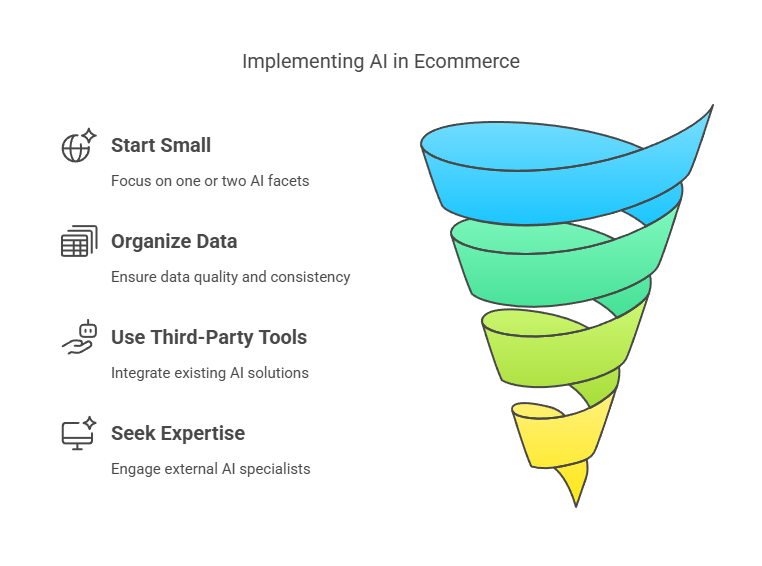
- Start Small: Pick one or two facets of AI you want to implement first (say, chatbots or a recommendation engine).
- Get Data in Order: Clean, consistent data is the bedrock of successful AI.
- Leverage Third-Party Tools: You don’t need to develop everything in-house. There are numerous AI-powered ecommerce solutions that can integrate seamlessly with your existing store.
- Seek External Expertise: This can mean hiring data scientists or partnering with specialized consultancies. If you’re evaluating how to structure your AI roadmap, our team at Buildfuture could provide valuable insight.
I used to advise clients that it’s okay not to have all the answers when starting out. The key is to remain curious and flexible, letting data guide your next steps.
Future Trends and AI-Driven Retail Innovations
We’ve already covered a wide breadth of AI tactics, but the technology isn’t slowing down. If anything, the future of AI in ecommerce will likely be more immersive and interactive. Here’s a glimpse of what’s on the horizon:
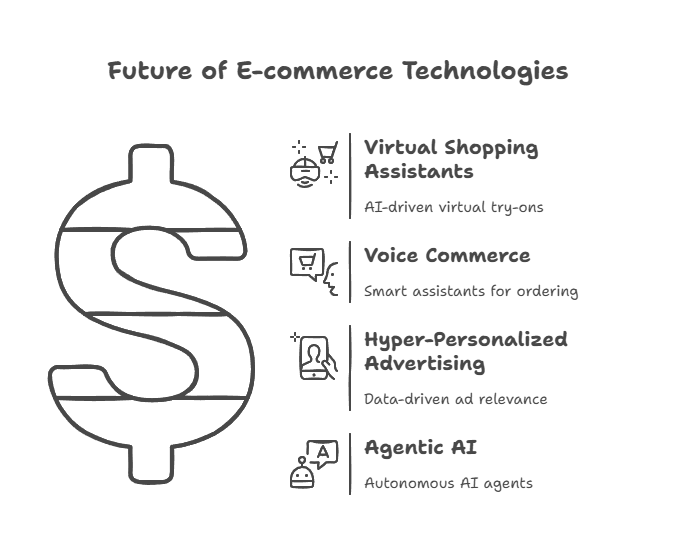
- Virtual Shopping Assistants: In the next few years, VR and AR experiences might converge with AI, allowing shoppers to virtually “try on” products.
- Voice Commerce: With the popularity of smart assistants, voice-based ordering is becoming a real factor. AI systems that understand speech patterns will further shape the ecommerce landscape.
- Hyper-Personalized Advertising: As data integrations grow, ads could become astonishingly relevant by tapping into browsing behavior, real-time location, or even biometric feedback.
- Agentic AI: The concept of advanced AI agents capable of learning in more autonomous and dynamic ways is gaining traction. This could profoundly alter how automated systems interact with users.
The truth is, we can’t fully predict how quickly these transformations will happen. I’m not entirely sure if we’ll see mass adoption of AR-based shopping in the next year or two—some argue it’s simply a question of when, not if.
If your company wants to stay on the cutting edge, you might consider exploring smaller pilot projects. Even if they don’t immediately generate a profit, they can prepare your organization for fast shifts in consumer behavior. That’s exactly the kind of strategic planning we assist with at Buildfuture. If you’d like a second opinion on emerging tech, we’re here for that too.
Real-World Examples of AI for Ecommerce Growth
- Style + Data: Virtual Fashion Boutique
A mid-sized online fashion retailer realized they were losing returning customers because their site felt too generic. By implementing machine learning in retail personalization, they served up curated “virtual wardrobes.” Conversion rates jumped by 20% in one quarter. - Automated Customer Service: Scale Beyond Humans
A prom dress brand faced an onslaught of repetitive questions every spring. They deployed AI-powered chatbots in ecommerce channels (their website and social media). Customer satisfaction climbed, and support staff could handle more complex queries. - Demand Forecasting: Electronics Retailer
A vendor of electronic gadgets encountered serious out-of-stock issues on top-selling items. Deploying predictive analytics for demand forecasting, they adjusted their inventory strategy weeks ahead of major shopping holidays. Sales soared, and their warehouses were optimized. - Dynamic Pricing: Sporting Goods Supplier
A sporting goods website adopted AI-driven pricing strategies, tweaking product costs based on competitor behavior and internal inventory. The result? A substantial increase in profit margins and improved competitiveness in high-demand seasons.
A Handy Comparison: Traditional vs. AI-Driven Approaches
Below is a quick reference table contrasting traditional ecommerce methods with AI-enhanced strategies. It’s not comprehensive, but it should give you a decent snapshot:
| Aspect | Traditional Ecommerce Approach | AI-Driven Ecommerce Approach |
|---|---|---|
| Customer Personalization | One-size-fits-all marketing campaigns | Tailored recommendations, dynamic offers |
| Pricing Strategies | Manual updates or static pricing | Automated real-time price adjustments |
| Chat Support | Limited hours staff-based support | 24/7 chatbot assistance with NLP |
| Inventory Forecasting | Spreadsheet-based, prone to human error | Predictive analytics with ML algorithms |
| Fraud Detection | Rule-based checks, frequent false flags | Adaptive AI monitoring for smarter alerts |
Bringing It All Together
It’s no exaggeration to say artificial intelligence is redefining what’s possible in online retail. From tailored product listings and AI-driven customer personalization to dynamic pricing and automated fraud detection, the breadth of AI for ecommerce marketing tools and techniques is dizzying. And it’s not just big well-funded brands seizing these opportunities; plenty of emerging ecommerce stores and medium-sized operations are successfully leveraging AI-driven pricing strategies, intelligent chatbots, and advanced inventory management to capture a competitive edge.
Have a feeling you might be missing out on opportunities to streamline your operations? If you’re struggling to figure out your starting point or next AI upgrade, our Buildfuture consultants would be happy to provide an extra set of eyes. We’ve guided brands through everything from establishing machine learning protocols to installing robust AI ecommerce analytics systems that interpret user traffic in real time.
So here’s the thing: The eCommerce landscape is only going to get more dynamic. Ignoring AI might work for a short while, but it won’t be long before your competitors surpass you in personalization, pricing agility, and overall customer satisfaction. You might want to check out our specialized resources on AI in ecommerce or schedule a consultation to see how we can help you adopt these technologies seamlessly.
Conclusion
We’ve explored how AI in ecommerce is revolutionizing personalization, automation, and data-driven insight. AI-powered ecommerce solutions open up new ways of connecting with your audience, optimizing inventory levels, and improving customer interactions. Even though there can be challenges like data acquisition or staff training, the potential payoff is massive. By harnessing everything from chatbots to predictive analytics, businesses can pivot quickly in a market that constantly evolves.
If you’re curious about any piece of this puzzle—maybe you want to develop a better recommendation engine, or maybe you’re ready to deploy that chatbot you’ve been putting off—Buildfuture is here to help. Artificial intelligence in ecommerce doesn’t have to be complicated. With a thoughtful approach and a willingness to iterate, you can stay ahead of the curve and delight your customers in ways you never imagined.
Ready to future-proof your ecommerce business? Partnering with Buildfuture could be your next big leap toward AI-driven growth. Let’s face it: the digital landscape is only going to get more competitive, and adopting AI now can help you shape your own success story. If you’ve got questions, let’s keep the conversation going. Chat soon!




